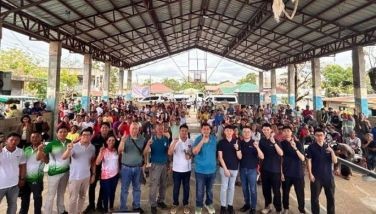Hunger is the enemy

“A hungry stomach knows no laws.” Former President and now Manila Mayor Joseph Estrada often recites this saying whenever presented with cases of breakdown of law and order. As a public official, Mr. Estrada applies this personal belief in addressing such human nature that drives people into breaking laws, if not committing crimes to stave off hunger.
Ousted as President in January 2001, Mr. Estrada has been guided by this adage in adopting a two-track approach on how the national to local government must address peace and order problems in our country.
The soft-approach policy of Estrada pursues his “Erap para sa Masa” platform of governance that supports dole-outs to the poor and marginalized sectors of society out of public funds. On the other hand, Estrada applies the iron-fist, or hard policy of the government to enforce the laws of the land to the fullest on whoever breaks them, whether the culprits are rich or poor.
Elected back into public office as mayor of Manila three years ago, Estrada –who is turning 79 years old this month – remains guided by this principle of governance. He seeks re-election in next month’s polls as mayor of the country’s capital city where poverty incidence is among the highest in the Philippines.
Estrada’s principle of governance came to mind as we talked about the April 1 violence-marred dispersal of sit-in protesters in Kidapawan, mostly composed of farmers and fisher folk affected by El Niño phenomenon, or the dry spell severely hitting North Cotabato. Claiming hunger and starvation of their families, the protesters reportedly demanded the release of promised sack of rice from the National Food Authority (NFA) for each of the El Niño-affected farmers and fisher folk in the province.
With the Kidapawan incident as our subject matter, we invited to our Kapihan sa Manila Bay last Wednesday the heads of two key government agencies directly involved in this case. They were, namely, Department of Agriculture (DA) Secretary Proceso Alcala and Department of the Interior and Local Government Undersecretary Peter Irving Corvera who came to represent DILG Secretary Senen Sarmiento.
But Alcala and Corvera were one in saying there was no food nor rice shortage to speak of as having caused the Kidapawan protest rally. “If it’s true that they have nothing to eat, prices of rice should have shot up. But that never happened,” Alcala pointed out.
While farmers’ grievances over drought impact to their crops were legitimate, the two Aquino officials insisted the hands of the Reds were all over the place at the protest rally in Kidapawan. They were supported by certain politicians who will remain unnamed for now until evidence are gathered to support criminal charges against them, Corvera vowed.
Both the DA and the DILG were the principal national government agencies being taken to task for the violence-marred Kidapawan sit-in protest last week by farmers and fisher folk. The DA in particular is being held to account for the complaints of farmers and fisher folk for its alleged failure, if not lacking assistance to El Niño-affected farms.
The DILG, on the other hand, is the national government agency in charge of the Philippine National Police (PNP) and local government units (LGUs).
The two officials quoted North Cotabato Gov. Emmylou Mendoza who noted most of the protesters were not even residents of Kidapawan but were “trucked” to their city after being promised that sacks of rice would be distributed to them at the provincial capitol.
One of the reported injured protesters while being treated in a government hospital, in fact, turned out to be one of the most wanted New People’s Army (NPA) leaders. He is now under police custody and one of 80 people charged by PNP for instigating the violence.
As of this writing, one policeman who was among the unarmed cops acting as crowd control units at the protest site, is still fighting for his life in hospital with a cracked skull.
The Commission on Human Rights (CHR) immediately stepped into the picture to investigate the reported abuses and excessive use of force by policemen in the removal and dispersal of protesters that reportedly caused the death of three farmers. The police action came on the third day of the sit-in protest which blocked traffic at the highway – a major road artery connecting the provinces of Cotabato and Davao.
Incidentally, the DILG is also conducting its own investigation into the incident and created two separate panels to look into the allegations against the provincial PNP units involved in the dispersal and another panel to probe the provincial LGUs supposed to implement El Niño-mitigating measures.
Yesterday, the Senate committee on justice and human rights, chaired by Sen. Aquilino Pimentel III, conducted their own inquiry in aid of legislation of the Kidapawan incident.
And it was also only yesterday that the PNP provincial director Senior Supt. Alex Tagum was relieved from his post pending completion of the DILG investigation.
PNP director-general Ricardo Marquez named Senior Superintendent Jose Briones Jr. to temporarily take over from Tagum. While the PNP chief earlier insisted the responding policemen conducted “legitimate law enforcement operation” to remove illegal roadblock by protesters, he acknowledged yesterday some of the cops involved in the dispersal fired their weapons.
As standard operating procedure (SOP) or rules of engagement of the PNP, lawmen are supposed to use non-lethal equipment for crowd control and dispersal.
But investigators recovered from the site 83 slugs of different calibers, mostly coming from firearms not issued by the PNP, Corvera revealed during our weekly Kapihan sa Manila Bay breakfast forum the other day at Cafe Adriatico in Remedios Circle in Malate, Manila.
In fact, the outnumbered policemen were the ones being attacked by the militants, Corvera noted as he played to us excerpts of a six-minute video taken by drone flown during those crucial moments to bolster the government version of the incident. While retreating, two of the policemen fell and were being brutally beaten either by wooden clubs and rocks while they were already pinned to the ground.
While there is no justification for violence, it is very difficult to wage a battle with a faceless enemy like hunger.
- Latest
- Trending























